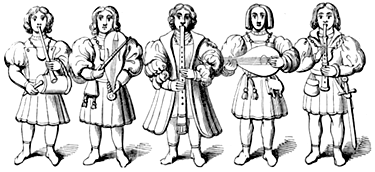
As composers of music became more ambitious in the Late
Middle Ages, they sought to write intricate polyphonic songs for ensembles,
and the challenging music demanded musicians increasingly specialize in
particular instruments, or families of instruments, and acquire professional
training. This undermined the role of the self-taught (or informally
apprenticed) and multi-instrumental wandering minstrel, much of whose
performance was based on improvisations on simple melodic themes.
Similarly, the growing taste for dramatic performances reduced the need
for the 'wandering minstrel as as bardic storyteller'. In some towns
we find evidence of minstrels' gilds at the close of the Middle Ages.
That at Beverley contributed to the rebuilding of St. Mary's church,
one of whose pillars bears a carving of a minstrel band, on which
the drawing above was based. Although the clothing worn by band members
appears Tudor, the instrumentation is typical of the Late Middle Ages
(from left to right):